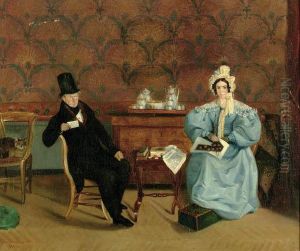Emile Mascre Paintings
Émile Mascre was a French artist known for his involvement in the Symbolist movement, which flourished in Europe during the late 19th century. Born on March 1, 1862, in Paris, Mascre was a painter, sculptor, and illustrator whose work often depicted mythological and dreamlike subjects. His style was characterized by a focus on the mystical and the spiritual, with an emphasis on the emotional and poetic aspects of art rather than on realistic representation.
Mascre’s artistic journey started at a young age when he displayed an aptitude for drawing and painting. He was educated at the École des Beaux-Arts in Paris, where he developed his skills under the tutelage of established artists of the time. Although he was trained in the academic tradition, Mascre was heavily influenced by the Symbolist movement's leaders, such as Gustave Moreau, and by the Pre-Raphaelite Brotherhood, whose works also favored complex symbolism and elaborate detail over naturalism.
Throughout his career, Mascre exhibited his works at various salons and galleries, becoming a recognized figure within the Symbolist community. His illustrations appeared in literary reviews and publications, connecting him with the literary aspect of the movement. Alongside his visual art, Mascre took an interest in writing, and his essays and poems further reflect his commitment to the ideals of Symbolism.
Despite his contributions to the movement, Émile Mascre remains less well-known than some of his contemporaries. His works did not achieve the same level of fame as those of Gustave Moreau or Odilon Redon, but they nonetheless represent an important facet of Symbolist art, particularly in their exploration of the subconscious and mystical realms.
Mascre continued to create art until his later years but faded from the public eye with the advent of new art movements such as Cubism and Surrealism, which shifted the direction of the avant-garde. He passed away on January 1, 1940, in Paris, leaving behind a body of work that, while not extensively celebrated, offers valuable insight into the Symbolist movement and the artistic transitions of the late 19th and early 20th centuries.
